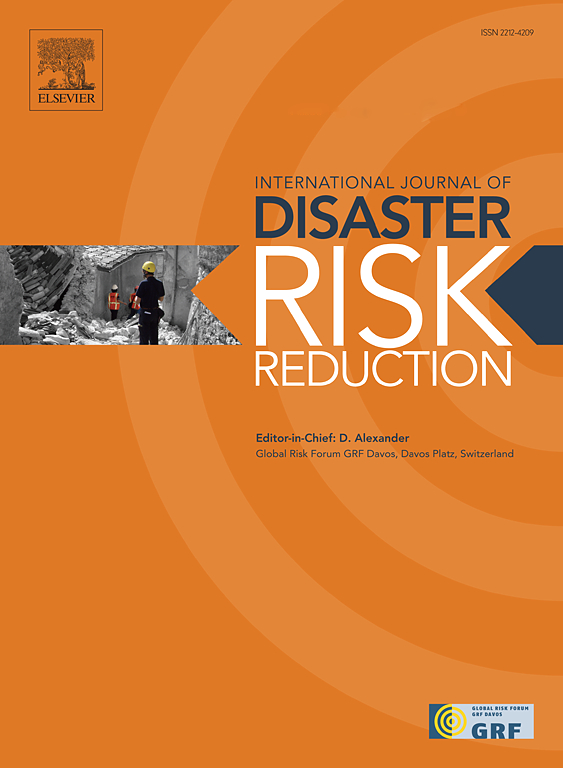Evaluating the impacts of earthquake disasters on the building construction sector: a SARIMA-based counterfactual analysis
IF 4.5
1区 地球科学
Q1 GEOSCIENCES, MULTIDISCIPLINARY
International journal of disaster risk reduction
Pub Date : 2025-07-09
DOI:10.1016/j.ijdrr.2025.105695
引用次数: 0
Abstract
Disasters have a dual effect on the construction industry. While their initial impact disrupts construction activities, the resulting damage also stimulates construction demand. Existing scholarly literature predominantly adopts qualitative approaches in examining the impacts of disasters on the sector. This study introduces a quantitative methodology to assess the impacts of disasters on building construction activity. Utilizing counterfactual time series analysis, trajectories of the construction sector in the absence of disasters are simulated and subsequently compared with actual observed trajectories. Building consent datasets were obtained from Statistics New Zealand and time series analysis was employed to investigate the effect of the Canterbury and Kaikoura earthquakes on the building construction sector, examining impacts at both national and regional levels. The findings reveal that the Canterbury earthquake had a significant national impact, initially decreasing construction activity but subsequently leading to more rapid growth in the medium to long term than anticipated. In contrast, the Kaikoura earthquake's impact was largely confined to the Canterbury region, slowing the local building construction sector. This study highlighted the usefulness of counterfactual time series analysis in assessing the impacts of disasters on the construction sector, and its findings are useful for simulating the impacts of disasters and other shocks in forecasting future trajectories of the sector.
评估地震灾害对建筑行业的影响:基于sarima的反事实分析
灾害对建筑行业有双重影响。虽然它们最初的影响扰乱了建筑活动,但由此造成的破坏也刺激了建筑需求。现有的学术文献在研究灾害对该部门的影响时主要采用定性方法。本研究引入一种定量方法来评估灾害对建筑施工活动的影响。利用反事实时间序列分析,模拟了在没有灾害的情况下建筑部门的轨迹,随后与实际观察到的轨迹进行了比较。从新西兰统计局获得建筑许可数据集,并采用时间序列分析来调查坎特伯雷和凯库拉地震对建筑行业的影响,检查国家和地区层面的影响。研究结果表明,坎特伯雷地震对全国产生了重大影响,最初减少了建筑活动,但随后在中长期内导致比预期更快的增长。相比之下,凯库拉地震的影响主要局限于坎特伯雷地区,减缓了当地建筑行业的发展。这项研究强调了反事实时间序列分析在评估灾害对建筑部门的影响方面的有用性,其研究结果有助于模拟灾害和其他冲击的影响,预测该部门的未来轨迹。
本文章由计算机程序翻译,如有差异,请以英文原文为准。
求助全文
约1分钟内获得全文
求助全文
来源期刊

International journal of disaster risk reduction
GEOSCIENCES, MULTIDISCIPLINARYMETEOROLOGY-METEOROLOGY & ATMOSPHERIC SCIENCES
CiteScore
8.70
自引率
18.00%
发文量
688
审稿时长
79 days
期刊介绍:
The International Journal of Disaster Risk Reduction (IJDRR) is the journal for researchers, policymakers and practitioners across diverse disciplines: earth sciences and their implications; environmental sciences; engineering; urban studies; geography; and the social sciences. IJDRR publishes fundamental and applied research, critical reviews, policy papers and case studies with a particular focus on multi-disciplinary research that aims to reduce the impact of natural, technological, social and intentional disasters. IJDRR stimulates exchange of ideas and knowledge transfer on disaster research, mitigation, adaptation, prevention and risk reduction at all geographical scales: local, national and international.
Key topics:-
-multifaceted disaster and cascading disasters
-the development of disaster risk reduction strategies and techniques
-discussion and development of effective warning and educational systems for risk management at all levels
-disasters associated with climate change
-vulnerability analysis and vulnerability trends
-emerging risks
-resilience against disasters.
The journal particularly encourages papers that approach risk from a multi-disciplinary perspective.
 求助内容:
求助内容: 应助结果提醒方式:
应助结果提醒方式:


